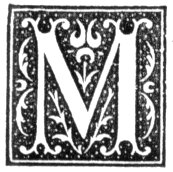
Sacred Texts Legends and Sagas Celtic Index Previous Next

|
"Fond father and mother, So guide it and feed it, Give gifts to it, clothe it: God only call know What lot to its latter days Life has to bring." |
 |
There is a variation of the last line:--
The following refers to the brow, the eye, the nose, and the mouth:--
Here is one about the fingers, beginning with the index finger:--
The nurse took hold of each finger as she repeated each line. There was another form of the rhyme, in which the thumb played the part of breaking the barn:--
Another form of the last line is:--
The legs and feet were utilised by the nurse as a means of amusement. Here is what she repeated while she held a leg in each hand and kept crossing them, slowly at first, and then with greater rapidity when the dogs were supposed to be on their homeward journey:--
Another version runs thus:--
The following rhyme was repeated to the child by the nurse while she took off the child's boot and imitated the blacksmith in nailing the shoes on the horse's foot:--
Here is another version:--
Another rhyme about the legs and feet is as follows:--
Various members of the body were celebrated in the following way:--
The next two lines must be left untold.
When the child was being fed, to keep it in good humour and induce it to take its food, the nurse kept repeating:--
A fuller version of the same was:--
When the child showed signs of being satisfied, the following words wore repeated:--
When the child was being undressed for bed, the nurse kept repeating:--
When the child got into the sulks it was called:--
Children in their amusements often repeated rhymes.
The following one was repeated when a child mounted a walking-stick or a piece of stick as a "horse":--
Another version is:--
This rhyme was repeated to the child when dandled on the knee in imitation of the modes of riding indicated in the lines:--
Another rhyme of the same kind is:--
Two children placed themselves back to back, locked their arms together, and alternately lifted each other, repeating the words:--
Here follow various rhymes current among the young:--
"A, B, buff,
Gee the cat a cuff,
Gee her ane, gee her twa,
Rap her hehd t’ the stehn wa’."
"Charlie Chats milkit the cats,
An Gollochy made the cheese,
An Charlie steed at the back o’ the door,
An heeld awa’ the flees."
"A for Annie Anderson,
B for Bettie Brown,
C for Cirstle Clapperton,
It danced upon her crown."
"A for Alexander,
B for Bettie Brown,
C for Kettie Clatterson,
It clatters throo the town."
"John Prott an his man
To the market they ran;
They bought, they sold,
Muckle money down told,
Till they came till a plack,
Steek your neive on that."
"'Hielanman, Hielanman,
Fahr wiz ye born?'
'Up in the Hielands,
Amon the green corn.'
'Faht got you there
Bit green kail an leeks?'
Laugh at a Hielanman
Wintin his breeks." p. 19
"The little lady lairdie
She longt for a baby,
She took her father's grey hunn
An row’d it in a plaidy.
Says 'Hishie, bishie, bow, wow,
Lang legit now ow
In’t warna for yir muckle baird
I wad kiss yir mou-ow'."
"Your plack an my plack,
Your plack an my plack,
Your plack an my plack an Jennie's bawbee,
We'll pit them i’ the pint stoup, pint stoup, pint stoup,
We'll pit them i’ the pint stoup,
An join a’ three."
"Matthew, Mark, Luke, air John
Haud the horse till I win on;
Haud him sicker, hand him sair,
Haud him by the auld mane hair."
"I've a cat wi’ ten tails,
I've a ship wi’ saiven sails,
Up Jack, down Tom,
Blow the bellows, old man."
"A bawbee bap,
A leather strap,
An a tow t’ hang the baker."
"Four-an-twenty tailors
Chasin at a snail,
The snail shot oot its horns
Like a hummil coo.
'Ah,' cried the foremost tailor,
'We're a’ stickit noo.'" 1
"Wallace wicht
Upon a nicht
Took in a stack o’ bere,
An or the moon at fair daylicht
Hid draff o’t till's more."
"That's the lady's forks an knives,
An that's the lady's table,
An that's the lady's looking-glass,
An that's the baby's cradle."
This rhyme was repeated on placing the fingers in such positions as to imitate knives, tables, &c.
The following is a rhyme on the numbers up to twenty:--
"Steal a needle, steal a preen,
Steal a coo or a’ be deen."
This sensible rhyme was often repeated to children when they were guilty of pilfering, or began to show any inclination to do so.
The following is called the "Souter's Grace":--
"What are we before thee, O King Crispin? Naething bit a parcel o’ easy ozy sooter bodies, nae worth one old shoe to mend another. Yet thou hast given us leather to yark, and leather to bark, oot-seam awls, and in-seam awls, pincers and petrie-balls, lumps o’ creesch and balls o’ rosit, and batter in a cappie. Amen."
19:1 Cf. Henderson, p. 26.